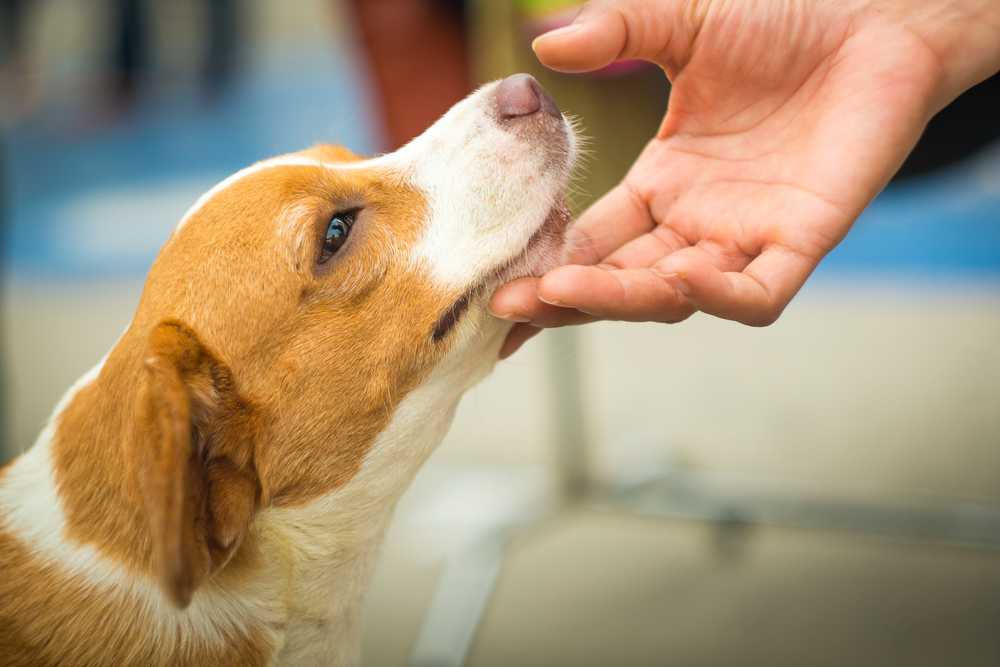Does your dog wag her tail and act happy when women and children come close, but crouch down, roll over on her back, and pee whenever a dude greets her?
Does she tuck her tail between her legs, pace around the room, or bark, growl, and snarl when a man shows up? If so, perhaps she’s afraid of men. Here’s how to help a dog feel safe and relaxed when a gentleman comes calling.
Not Uncommon
Your dog’s fear of the male sex isn’t rare. Many people report this common behavior and attribute their dogs’ jitters to abuse by males early in life or in a previous home. While it’s possible traumatic experiences may have caused the heebie-jeebies, it’s likely not the only reason. Social and physical factors contribute to the fear puzzle.
“There are several explanations,” says Ellen M. Lindell, VMD, a board-certified veterinary behaviorist. “Many puppies are raised by women, rather than by men, so pups grow up feeling more connected to women.”
Place some blame, too, on the canine nose. Dogs possess a keen sense of smell and can detect the difference in male and female scents caused by hormones and personal care products. If raised by a female breeder, puppies have known her scent since birth. Men, not so much.
Fearful dogs are sensitive to human behaviors and appearances and may react negatively to some of them. These include a larger body, a loud, booming tone of voice, facial hair, or a hat shading the face. Dogs can interpret abrupt movements, roughhousing, or hovering over them for petting as confusing and intimidating.
Often these traits and actions are not always separated along gender lines. “If a dog was never exposed to people who look or act this way as a puppy, she can feel threatened and will tend to shy away from them,” says Dr. Lindell.
Spending time early in life with only one person rather than several limits a dog’s comfort level as well.
Changing the Story
Whatever the reason your dog acts uncomfortably nervous around anyone with a large and too-noisy presence, you can take steps to ease her anxiety. You’ll need patience, planning, and training, but the results will pay off. A dog that has a fear of people may never develop an outgoing, happy-go-lucky personality when it comes to meeting men, but she can learn to relax more in their presence.
Begin by identifying details that trigger your dog’s fearful response. This will help you narrow the type of exposure and training your dog will need to reduce her fright.
Observe how your dog reacts when she sees a large person wearing a hat or sporting a beard or mustache. Notice if she shies away from someone who leans over her, rushes toward her, or has a loud, boisterous personality.
Self-Esteem Setups
Slowly build your dog’s confidence by setting up opportunities for her to approach the type of people she’s afraid of. Ask a series of friends to wear a hat or a fake beard and meet you separately at different locations. Let your dog decide how close she wants to approach them.
To help eliminate your dog’s underlying reason for feeling afraid of men, psychologists recommend following a desensitizing and counterconditioning plan. This structured method involves patient training over several weeks or months and should avoid retriggering the fear. Here’s where a board-certified veterinary behaviorist, certified applied animal behaviorist, or a certified professional dog trainer or behavior consultant can assist.
Start by showing or exposing your dog to a large, noisy, or otherwise frightening man standing still at a distance. Make sure your dog notices him, but doesn’t feel scared. Give your dog a pre-approved high-value treat she really loves.
The idea is for your dog to associate the fearful person with receiving something good. When the person is out of sight, stop giving the treat. Repeat this process at least 10 times.
Over several days or weeks, gradually repeat this training. Shorten your distance from where the man is standing, but ask him not to look directly at, and not to reach toward your dog. Give your dog several tasty treats and then move away again. This creates a positive reaction.
Practice, Treat, Repeat
Repeat this process multiple times and follow it immediately with delicious treats. Avoid frightening your dog. If she shows any fear, move further away from the man and next time do not approach as close. Vary the location and the time of day of these sessions until your dog is comfortable with the person standing closer. Your dog does not have to meet or be touched by the person. She might not be ready for that and it is not necessary for people on walks to touch your dog.
Never push your dog beyond her comfort zone. Forcing your dog to accept petting from someone she’s afraid of will only strengthen her fear.
It also helps to engage your dog in other fun actives such as play or practicing known behaviors. Keep your dog moving instead of stationary. Stopping and asking her to ignore something she perceives as a threat is not setting her up for success. Instead have her do some of her favorite behaviors such as spin or touch (nose touch to your hand) and follow them up with a treat. You can also play with her with one of her favorite toys. If your dog can’t respond to known cues, take treats, or play with you, she might be too nervous, indicating you need to increase your distance from the man.
Throughout your training, remain patient and positive. Your dog will pick up on your energy and emotions and reflect your feelings. If your dog continues to act fearful around men and behaves aggressively, contact a board-certified veterinary behaviorist for assistance. Some fears can worsen if not treated promptly and appropriately.
This article was reviewed/edited by board-certified veterinary behaviorist Dr. Kenneth Martin and/or veterinary technician specialist in behavior Debbie Martin, LVT.








